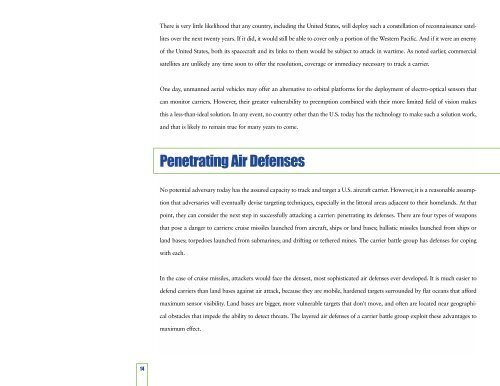aircraft-carrier-invulnerability
aircraft-carrier-invulnerability
aircraft-carrier-invulnerability
You also want an ePaper? Increase the reach of your titles
YUMPU automatically turns print PDFs into web optimized ePapers that Google loves.
There is very little likelihood that any country, including the United States, will deploy such a constellation of reconnaissance satellites<br />
over the next twenty years. If it did, it would still be able to cover only a portion of the Western Pacific. And if it were an enemy<br />
of the United States, both its spacecraft and its links to them would be subject to attack in wartime. As noted earlier, commercial<br />
satellites are unlikely any time soon to offer the resolution, coverage or immediacy necessary to track a <strong>carrier</strong>.<br />
One day, unmanned aerial vehicles may offer an alternative to orbital platforms for the deployment of electro-optical sensors that<br />
can monitor <strong>carrier</strong>s. However, their greater vulnerability to preemption combined with their more limited field of vision makes<br />
this a less-than-ideal solution. In any event, no country other than the U.S. today has the technology to make such a solution work,<br />
and that is likely to remain true for many years to come.<br />
Penetrating Air Defenses<br />
No potential adversary today has the assured capacity to track and target a U.S. <strong>aircraft</strong> <strong>carrier</strong>. However, it is a reasonable assumption<br />
that adversaries will eventually devise targeting techniques, especially in the littoral areas adjacent to their homelands. At that<br />
point, they can consider the next step in successfully attacking a <strong>carrier</strong>: penetrating its defenses. There are four types of weapons<br />
that pose a danger to <strong>carrier</strong>s: cruise missiles launched from <strong>aircraft</strong>, ships or land bases; ballistic missiles launched from ships or<br />
land bases; torpedoes launched from submarines; and drifting or tethered mines. The <strong>carrier</strong> battle group has defenses for coping<br />
with each.<br />
In the case of cruise missiles, attackers would face the densest, most sophisticated air defenses ever developed. It is much easier to<br />
defend <strong>carrier</strong>s than land bases against air attack, because they are mobile, hardened targets surrounded by flat oceans that afford<br />
maximum sensor visibility. Land bases are bigger, more vulnerable targets that don't move, and often are located near geographical<br />
obstacles that impede the ability to detect threats. The layered air defenses of a <strong>carrier</strong> battle group exploit these advantages to<br />
maximum effect.<br />
14


